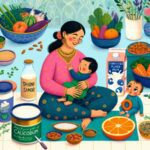Managing lactose intolerance in toddlers naturally begins with understanding the condition and recognizing the signs in your little one. Lactose intolerance occurs when the body produces low levels of lactase, the enzyme needed to digest lactose, a sugar found in milk and dairy products. This can lead to discomfort, including bloating, gas, and diarrhea, making it crucial for parents to find alternative ways to meet their toddler’s nutritional needs without causing distress.
Understanding Lactose Intolerance in Toddlers
Lactose intolerance can vary in severity, with some toddlers experiencing mild symptoms that can be managed with dietary adjustments, while others may require a more strict avoidance of lactose. Identifying lactose intolerance early on can help in managing symptoms and ensuring your toddler receives the essential nutrients for healthy growth and development. Adequate calcium, vitamin D, and protein intake are particularly crucial.
To learn more about the signs of lactose intolerance and potential solutions, consider exploring Lactose Intolerance in Infants: Signs and Solutions, which provides a comprehensive guide on the condition.
Managing Lactose Intolerance in Toddlers Naturally
Managing lactose intolerance in toddlers naturally involves a combination of dietary modifications and introducing lactose-free alternatives to ensure they still receive vital nutrients. For many parents, the challenge lies in balancing a lactose-free diet with the nutritional needs of a growing toddler.
Start by introducing lactose-free milk alternatives such as almond, soy, or coconut milk, which can provide the necessary calcium and vitamin D. It’s also essential to incorporate other calcium-rich foods into their diet, like broccoli, kale, and fortified cereals. For additional guidance on dairy-free sources of calcium for toddlers, click here.
Nutritional Alternatives for Lactose-Intolerant Toddlers
When managing lactose intolerance in toddlers naturally, it’s vital to seek out nutritional alternatives that compensate for the absence of dairy products in their diet. This means finding viable sources of essential nutrients like calcium, vitamin D, and protein, which are commonly obtained from dairy.
In addition to milk alternatives, consider incorporating a variety of foods into your toddler’s diet. Foods rich in calcium, such as oranges, figs, and tofu, can help. Vitamin D can be sourced from eggs and fatty fish like salmon, while lean meats, beans, and lentils can provide the necessary protein. For more ideas on integrating these foods into your toddler’s meals, discover these nutritious and delicious smoothie recipes for toddlers.
Remember, every toddler is unique, and it’s crucial to monitor their reaction to new foods while managing lactose intolerance naturally. For personalized advice, consulting a pediatric nutritionist can provide tailored dietary plans that meet your child’s specific needs.
For more detailed information on managing dietary concerns in toddlers, such as lactose intolerance, click here to access a wealth of resources designed to support parents through these challenges.













